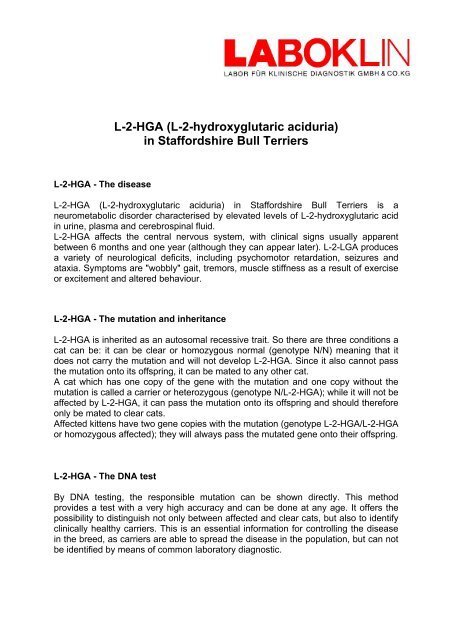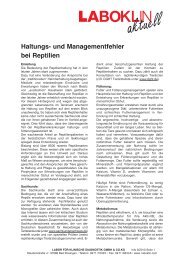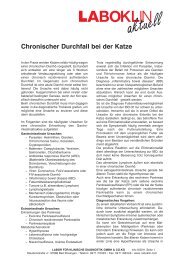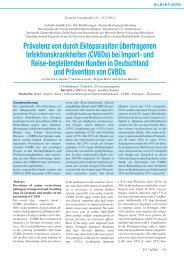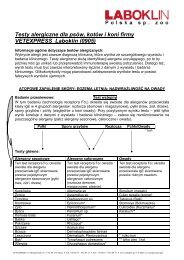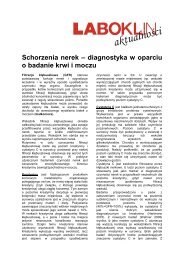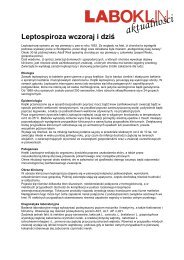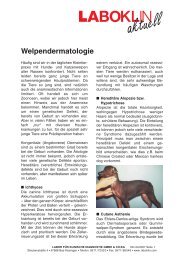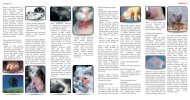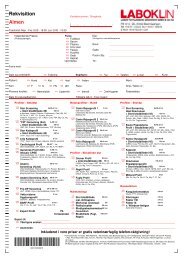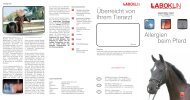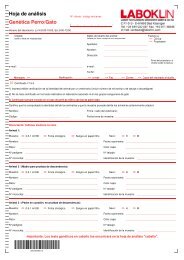L-2-HGA (L-2-hydroxyglutaric aciduria) in Staffordshire ... - Laboklin
L-2-HGA (L-2-hydroxyglutaric aciduria) in Staffordshire ... - Laboklin
L-2-HGA (L-2-hydroxyglutaric aciduria) in Staffordshire ... - Laboklin
You also want an ePaper? Increase the reach of your titles
YUMPU automatically turns print PDFs into web optimized ePapers that Google loves.
L-2-<strong>HGA</strong> - The disease<br />
L-2-<strong>HGA</strong> (L-2-<strong>hydroxyglutaric</strong> <strong>aciduria</strong>)<br />
<strong>in</strong> <strong>Staffordshire</strong> Bull Terriers<br />
L-2-<strong>HGA</strong> (L-2-<strong>hydroxyglutaric</strong> <strong>aciduria</strong>) <strong>in</strong> <strong>Staffordshire</strong> Bull Terriers is a<br />
neurometabolic disorder characterised by elevated levels of L-2-<strong>hydroxyglutaric</strong> acid<br />
<strong>in</strong> ur<strong>in</strong>e, plasma and cerebrosp<strong>in</strong>al fluid.<br />
L-2-<strong>HGA</strong> affects the central nervous system, with cl<strong>in</strong>ical signs usually apparent<br />
between 6 months and one year (although they can appear later). L-2-LGA produces<br />
a variety of neurological deficits, <strong>in</strong>clud<strong>in</strong>g psychomotor retardation, seizures and<br />
ataxia. Symptoms are "wobbly" gait, tremors, muscle stiffness as a result of exercise<br />
or excitement and altered behaviour.<br />
L-2-<strong>HGA</strong> - The mutation and <strong>in</strong>heritance<br />
L-2-<strong>HGA</strong> is <strong>in</strong>herited as an autosomal recessive trait. So there are three conditions a<br />
cat can be: it can be clear or homozygous normal (genotype N/N) mean<strong>in</strong>g that it<br />
does not carry the mutation and will not develop L-2-<strong>HGA</strong>. S<strong>in</strong>ce it also cannot pass<br />
the mutation onto its offspr<strong>in</strong>g, it can be mated to any other cat.<br />
A cat which has one copy of the gene with the mutation and one copy without the<br />
mutation is called a carrier or heterozygous (genotype N/L-2-<strong>HGA</strong>); while it will not be<br />
affected by L-2-<strong>HGA</strong>, it can pass the mutation onto its offspr<strong>in</strong>g and should therefore<br />
only be mated to clear cats.<br />
Affected kittens have two gene copies with the mutation (genotype L-2-<strong>HGA</strong>/L-2-<strong>HGA</strong><br />
or homozygous affected); they will always pass the mutated gene onto their offspr<strong>in</strong>g.<br />
L-2-<strong>HGA</strong> - The DNA test<br />
By DNA test<strong>in</strong>g, the responsible mutation can be shown directly. This method<br />
provides a test with a very high accuracy and can be done at any age. It offers the<br />
possibility to dist<strong>in</strong>guish not only between affected and clear cats, but also to identify<br />
cl<strong>in</strong>ically healthy carriers. This is an essential <strong>in</strong>formation for controll<strong>in</strong>g the disease<br />
<strong>in</strong> the breed, as carriers are able to spread the disease <strong>in</strong> the population, but can not<br />
be identified by means of common laboratory diagnostic.
To ensure maximum test reliability, the test is always performed <strong>in</strong> two <strong>in</strong>dependent<br />
test runs per sample.<br />
Requirements<br />
The test is performed out of EDTA whole blood (0.5 ml) or special cytobrushes.<br />
These cytobrushes are available upon request and free of charge. Test<strong>in</strong>g is<br />
performed a few times per week. The results are due about 3-5 work<strong>in</strong>g days after<br />
arrival of the sample <strong>in</strong> our laboratory.<br />
For further <strong>in</strong>formation please contact Dr. Petra Kühnle<strong>in</strong> or Dr. Ines Langbe<strong>in</strong>-<br />
Detsch<br />
LABOKLIN GmbH u. Co. KG, Steubenstraße 4, D-97688 Bad Kiss<strong>in</strong>gen<br />
Phone: +49-971-72020, Fax: +49-971-7202995, Email: labogen@labokl<strong>in</strong>.de


